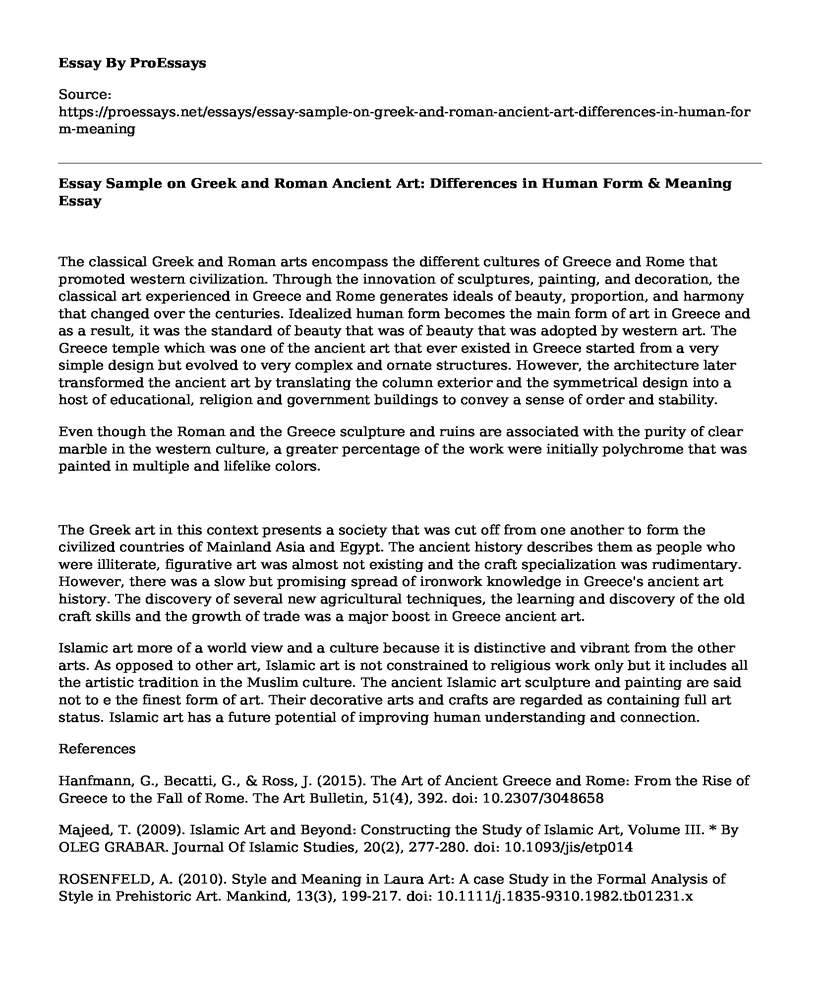The classical Greek and Roman arts encompass the different cultures of Greece and Rome that promoted western civilization. Through the innovation of sculptures, painting, and decoration, the classical art experienced in Greece and Rome generates ideals of beauty, proportion, and harmony that changed over the centuries. Idealized human form becomes the main form of art in Greece and as a result, it was the standard of beauty that was of beauty that was adopted by western art. The Greece temple which was one of the ancient art that ever existed in Greece started from a very simple design but evolved to very complex and ornate structures. However, the architecture later transformed the ancient art by translating the column exterior and the symmetrical design into a host of educational, religion and government buildings to convey a sense of order and stability.
Even though the Roman and the Greece sculpture and ruins are associated with the purity of clear marble in the western culture, a greater percentage of the work were initially polychrome that was painted in multiple and lifelike colors.
The Greek art in this context presents a society that was cut off from one another to form the civilized countries of Mainland Asia and Egypt. The ancient history describes them as people who were illiterate, figurative art was almost not existing and the craft specialization was rudimentary. However, there was a slow but promising spread of ironwork knowledge in Greece's ancient art history. The discovery of several new agricultural techniques, the learning and discovery of the old craft skills and the growth of trade was a major boost in Greece ancient art.
Islamic art more of a world view and a culture because it is distinctive and vibrant from the other arts. As opposed to other art, Islamic art is not constrained to religious work only but it includes all the artistic tradition in the Muslim culture. The ancient Islamic art sculpture and painting are said not to e the finest form of art. Their decorative arts and crafts are regarded as containing full art status. Islamic art has a future potential of improving human understanding and connection.
ReferencesHanfmann, G., Becatti, G., & Ross, J. (2015). The Art of Ancient Greece and Rome: From the Rise of Greece to the Fall of Rome. The Art Bulletin, 51(4), 392. doi: 10.2307/3048658
Majeed, T. (2009). Islamic Art and Beyond: Constructing the Study of Islamic Art, Volume III. * By OLEG GRABAR. Journal Of Islamic Studies, 20(2), 277-280. doi: 10.1093/jis/etp014
ROSENFELD, A. (2010). Style and Meaning in Laura Art: A case Study in the Formal Analysis of Style in Prehistoric Art. Mankind, 13(3), 199-217. doi: 10.1111/j.1835-9310.1982.tb01231.x
Cite this page
Essay Sample on Greek and Roman Ancient Art: Differences in Human Form & Meaning. (2023, Feb 26). Retrieved from https://proessays.net/essays/essay-sample-on-greek-and-roman-ancient-art-differences-in-human-form-meaning
If you are the original author of this essay and no longer wish to have it published on the ProEssays website, please click below to request its removal:
- Iconography, Symbolism, and Functions of Stained Glass Windows of Gothic Cathedrals
- Horror Films Festivals
- Analysis of a Scene From Harvest Essay Example
- Representation of Time in Modernist Literature Essay
- Most Important Event in History: World War II - Essay Sample
- The American Revolution: From Proclamation to War - Essay Sample
- Essay Example on Teen Magazines: Keeping Teens in the Know!







